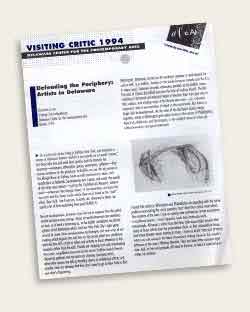Article Title
Defending the Periphery: Artists in Delaware (excerpt)
Elizabeth
Licata
Visiting Critic-in-Residence
Delaware Center for the Contemporary Arts
Winter 1994
As a critic and curator living in Buffalo, New York, one becomes a master of defensive rhetoric. Buffalo is not exactly an art world "center," but those who live and work here quickly learn to treasure the resources--museums, alternative spaces, universities, galleries--that sustain existence on the periphery. In Buffalo, we see the big names at the Albright-Knox Art Gallery, keep up with performance, video, and installations at Hallwalls Contemporary Arts Center, and make the rounds of the other area venues--such as the Castellani Art Museum, where I work--whenever they change shows. In the meantime, we enjoy the low rents and the cheap meals which allow us to travel to the "real" cities: New York, San Francisco, Toronto, etc. Once we're there, we spend a lot of time explaining how great Buffalo is.
Recent developments, however, have led me to suppose that this pitiful, wistful existence may change. Many art world observers are predicting an end, or at least a loosening up, in the tightly centralized circulatory system of art distribution which now has New York City's tight grasp around its aorta. New communication technologies and new ways of art-making which depend less and less on the sacred object are combining with the late 80's crash in values and activity to focus attention on the conduits rather than the cells. People are stepping back and reevaluating the scene, as galleries close and on-line artist's bulletin boards flourish. University galleries and museum are showing emerging artists, alternative spaces are taking traveling shows of established artists, and smaller cities are learning that they don't need to go to New York to find out what's happening.

Wilmington, Delaware, located on the northeast pipeline, is well-situated
for such a shift, as is Buffalo, located on the border between Canada
and the U.S. In many ways, Delaware provides interesting parallels to
the Buffalo scene. The land of Charles Burchfield becomes the land of
Andrew Wyeth. The flat stretches of farmland and industrial blight of
Western New York give way to hills, valleys, and winding roads of the
Brandywine area--yet, suburban expansion casts it own variation of blight
on the countryside. But there's a bright side to development. As the cities
of the Northeast slowly merge together, artists in Wilmington gain easier
access to the scenes of Philadelphia, New York, Baltimore, and Washington,
a star-studded cluster of urban grit, cultural resources, and good restaurants.
I found that artists in Wilmington and Philadelphia are grappling with the same problems and asking the same questions that I hear from artists everywhere. The majority of the work I saw as visiting critic centered on formal resolutions in traditional genres--more figurative work than landscape work, interestingly. Although a visitor from the New York scene might assume that many of these artists shun the postmodern idiom, or that sociopolitical issues and critical theories mean nothing to them, I have no doubt that most of these artists are well versed in the latest innovations making waves in this month's Artforum or this year's Whitney Biennial. They just have other concerns right now. And, as too many people still need to discover, it doesn't need to be an either/or situation.
During my initial look at the DCAA slides, I expected to find more artists celebrating the beauties of this area than I did, but it turned out that a different breed of artist was using landscape and the figure as ways of translating the physical into the spiritual, the psychological, and--rarely--the sociopolitical. Most important, they were using ideas rather than effects as the basis for their explorations. Vivian Wolovitz, one of the first artists I visited, paints misty spiritual landscapes which hover in and out of abstraction, strongly asserting their physical make-up of battered canvas and paint. Wolovitz defines paints ability to be a smelly, dripping, viscous substance which at the same time asserts the sublime in nature and in us. Her canvases are often deliberately patched together; she pushes the illusion as far towards fragmentation as she can while maintaining a lifeline of subtle, crystalline technique. Linda Schmid is also using physical topography, but more as a framework for creating minutely scratched and personal maps, in which quirky caricatures pop up every now and then. Here again, surface is essential, drawing the viewer in to examine what can't be seen from a distance. Although she works from organic references, Schmid is also defining a coded language more than a presence, a language filled with intelligence and flashes of humor.

